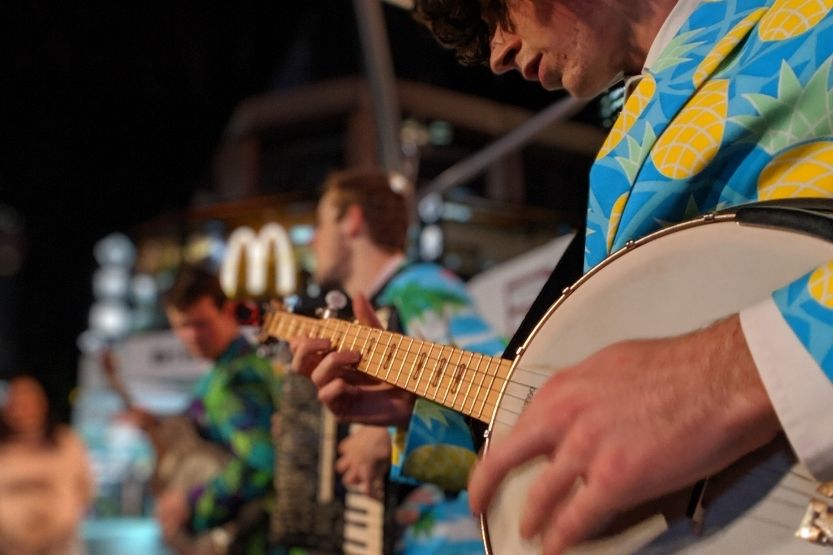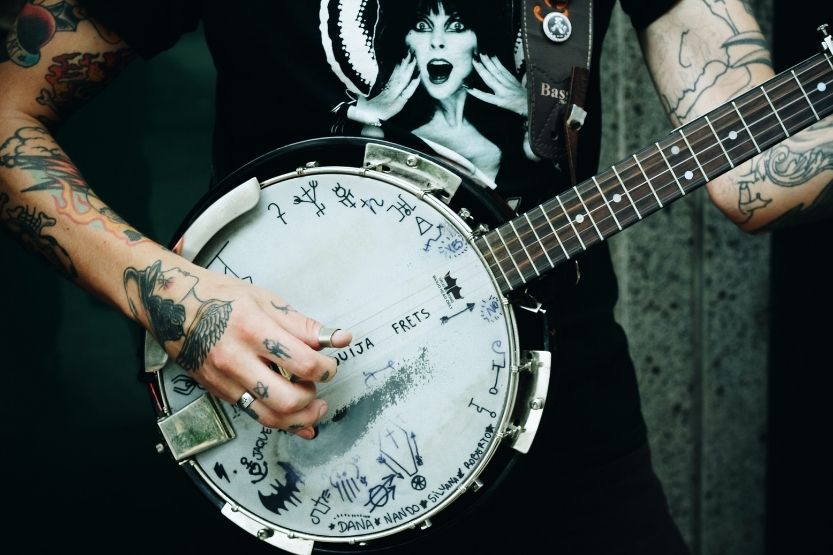It’s important to know how to tune it properly to get the best sound. Tuning a banjo is not difficult if you know what to do. How to tune a banjo?
The most common way of tuning a 5-string banjo is by tuning it in Open G. The strings used in Open G tuning are 5th string – G, 4th string – D, 3rd string – G, 2nd string – B, 1st string – D.
When you strum your banjo freely, without pressing any chords, it plays a G chord. So you would tune your banjo using the Open G Tuning. Other ways to tune a banjo include Double C tuning, C tuning, D tuning, and G modal tuning.
Read on to learn more about how to tune a banjo and how to know if your banjo is in tune or not.
Also, we hope you find the links here useful. We may get a commission if you purchase something through a link on this page, so thank you!
How to Tune a Banjo?

The common banjo with 5 strings is tuned in open G. Open G tuning is the most common tuning method used for banjos. This method tunes the banjo’s five strings to the G major chord notes.
Tuning the banjo to open G means playing a G chord without pressing on any chords on the neck when you freely strum the banjo.
Unless your banjo is seriously out of tune, normal tuning requires the tuning peg’s minimal turning. Start by turning one peg first a little while trying to listen to whether the pitch is going up or going down as you very slowly turn the peg.
If you can identify if it is going up or down, you’ll be able to tune your banjo.

Click here to see Kmise Banjo Ukulele Concert Size on Amazon.
When your strings are only slightly out of tune, you’ll only need to adjust the pegs with tiny turns. It takes practice and experience to be able to turn the pegs ever so slightly. If you have difficulty doing this, keep practicing. Practice makes perfect.
There are various ways you can use to tune a banjo. How to Tune a 5-String Banjo?
Here are five tuning methods:
1. Open G Tuning
This is the most used tuning method by banjo players. The pitches used per string in Open G tuning are:
5th string – G, 4th string – D, 3rd string – G, 2nd string – B, 1st string – D
However, only three pitches are used in Open G tuning, and they are G, B, and D. The 1st string and the 5th string are higher in pitch by an active as compared to the 4th string and the 5th string.
So, why is it good to use Open G tuning? Open G tuning lets you play the G chord without needing to press strings with your fretting hand. Other major chords can be performed in Open G tuning with the use of barre fingering. This makes it easy to do slide playing on the banjo.
Open G tuning gives off tunes that sound more whole compared to standard tuning.
2. Double C Tuning
This kind of tuning uses the strings G, C, G, C, and D. It is called double C tuning because the banjo uses 2 C strings.
3. C Tuning
This kind of tuning is also called Drop C Tuning simply because from the Open G Tuning, the D string or the 4th screen is dropped and is made into a C. The strings used are G, C, G, B, D.
4. D Tuning
This kind of tuning uses F#, D, F#, A, and D strings. An alternative to this is using the A string on the 5th string instead of the F#. You’ll still get the D tuning for this. If you strum and do not do any fretting, the D chord is what you will be playing.
5. G Modal
This method is mostly for playing most of the old-time tunes and some of the classics. This is probably the closest to the standard tuning in G. it uses the strings G, D, G, C, D. As you can see, only the 4th string is changed to C from a B in Open G Tuning.
The third of the G chord is removed and creates a G sus chord. The modal sound is created because you won’t differentiate between a major and minor chord when you remove the third chord. So if you want to know how to tune banjo strings, simply follow the above tuning methods: open G, double C, C, D, or G Modal.
How Do You Check If Your Banjo Is Tuned or Not?
Here is a quick way to check this:
- Match your pairs of strings and notes;
- The open first string should be the same note as a second-string on the third fret;
- Check if your open second string is the same note as the third-string on the third fret; and
- Your open third string is the same note as a fourth-string on the fifth fret. Your open fifth string is the same note as the first string on the 5th fret.
How to Tell When It’s Time to Tune Your Banjo?

Yes, it’s easy to use an electronic tuner to tell if your banjo needs tuning. However, it is essential to cultivate your sense of pitch so that you can tell if your banjo is tuned by ear.
To do this, it is a good idea to tune your banjo every time you’re about to play so that you can develop your ear and learn how a tuned banjo sounds like.
Your ear is far more appreciative of music than any electronic tuner. And so, when you tune by ear, you can do further than what the electronic tuner can do.
One more good reason to tune by ear is to let you play with other performers who do not use a concert pitch. Concert pitch refers to the manner of tuning musical instruments for preparation to be used in a performance.
How to Tune a 4 String Banjo?
Four-string banjos are tenor banjos. They have a shorter neck than 5 string banjos. There are two varieties of banjos – 17 and 19 fret banjos. A pick is used when playing the tenor banjo.

Click here to see this Vangoa Banjo Uke on Amazon.
They are most often used for classical jazz or Irish music.
How to tune a 4 string banjo? How to tune a tenor banjo? You can tune a tenor banjo in the fifths, like viola and cello.
You can tune a tenor banjo two ways using the fifths:
Standard Tuning
C3, G3, D4, A4 tuning, the same way you tune a viola and cello.
Irish Tuning
G2, D3, A3, E4 tuning, the same way you tune a mandolin or tenor violin.
The less common method of tuning banjos refers to Chicago tuning. This is like tuning a guitar using the first 4 strings – D, G, B, E.
When you tune a tenor banjo in the fifths, you get chord voicings wider in pitch, so you get a clear and more whole tone.
Banjo: History and Evolution
The first well-known performer of the banjo is Joel Sweeney, back in the 1800s. People say that he was the one who added the banjo’s 5th string and frets to the neck.
Fifth String
The fifth string is attached to a tuning peg that fits halfway to the neck’s side. This 5th string is shorter than the 4 regular strings.
With the strings designed as such, various playing styles were soon developed. However, playing a 5 string banjo is very much different from playing a guitar or mandolin.
The classical 5-string banjo became hugely popular between the late 1800s to the 1900s. Players who use the classical banjo uses it by picking the strings just like classical players play the classical guitar. Back then, the banjo was more popular than the guitar.
They were made from gut strings (made from animal intestines), and animal hide was used for drum skins. The animal hides were quite easy to break because they were very fragile. Later on, sturdier banjos were made with plastic drum skins.
Banjo Makeover
Musicians put the banjo in a makeover in the 1920s when jazz started to emerge. It gained popularity as a rhythm instrument.
It was also then that musicians discovered that they could play the banjo loudly and accompany saxophones, drums, and trumpets.
They then discovered that when the fifth string could be removed without affecting the sound and rhythm, it made banjo playing much easier. So, by the 1930s, most banjo manufacturers were producing banjos with only four strings.
Earl Scruggs
The history of the banjo won’t be complete without mentioning Earl Scruggs. In the 1920s, while still a child, he discovered how to play a 5-string banjo in an entirely different way.
He’s famous for “Three Finger Picking,” a playing style basically using the thumb and first two fingers of the right hand. He was the one who innovated the pick.
A pick is a small device like a ring. He wears this on the fingers’ end to pluck the strings. Using a pick allows you to play with more precision, power, and speed than when using only the bare finger.
Earl Scruggs became well-known after his professional debut when he was 16. It has since been known as Bluegrass music, taking its name from the band he first played called Bluegrass Boys.
Again, how to tune a banjo? Several banjo players tune their banjo using the most common method, Open G. This means that they play a G chord without pressing any other chords while strumming.
How Do Banjos Work?


Click here to see this AKLOT 5 String Banjos on Amazon.
Banjos have various parts that work together to produce acoustic power. Let’s take a look at how all these parts work together:
1. Vibrating Membrane
The banjo’s membrane is the material that is stretched over a cavity and forms a resonator. The material used for the membrane is either plastic or animal skin. The membrane of the banjo is key to creating soulful, expressive music.
A light strumming on the banjo’s strings will give you a delicate, pleasing musical sound, and heavier strumming will give you a powerful, soulful sound that can be carried even over long distances. The banjo has that power – to be able to be played quietly and also with great power.
2. Rim
The rim of the banjo is usually wooden and round. It is where the head is stretched over. A well-made banjo will have a three-ply rim made from maple wood. A solid rim made of maple is the heart of the banjo.
3. Tone Ring
The tone ring is located over the rim and under the banjo’s head. It is usually made of a metal that has resounding properties like brass or bronze. Sometimes a banjo will be made from wood but isn’t too common.
A tone ring must be fit properly to expand the banjo’s tone characteristics. With a properly made tone ring, the banjo will have both the tone ring and the rim vibrate as one.
A well-made and properly fitted tone ring enhances the bass response of the banjo. The sound will be richer and fuller.
Banjoists who do fingerpicking usually pick banjos with heavier tone rings made from metal. The banjo becomes more responsive when you use bare fingers to strike the strings because the metal tone ring enhances bass and treble.
Conclusion – How to Tune a 5 String Banjo?
Tuning a banjo is easy. Most banjo players choose to tune their banjos in Open G. Open G tuning is the most common tuning method used for banjos.
This method tunes the banjo’s strings to the G major chords. Banjo tuning to open G means playing a G chord without pressing on any chords on the neck when you freely strum the banjo.
As mentioned earlier, it is always best to check if your banjo is in tune just before every time you play. The quicker you know that your banjo is out of tune, the easier it is to return it in tune. Happy banjo playing!
Related reading:
How to Play Banjo – 10 Tips for Beginners
Mandolin Vs Banjo – How Do They Compare?
Best Banjos – Our Top 10 Picks









